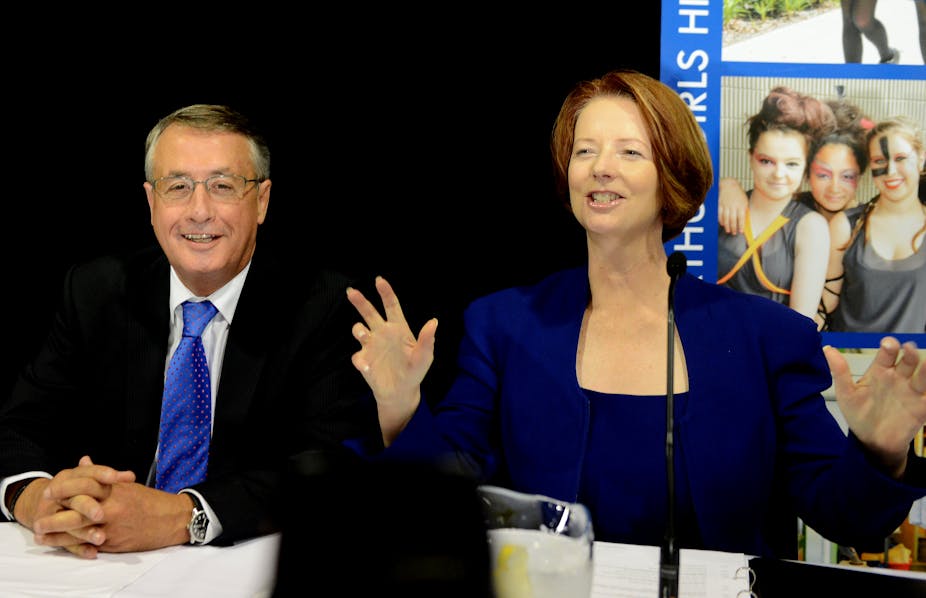By all accounts, in person Prime Minister Julia Gillard is relaxed, funny, engaging and a good listener. Her ministers say she is tough, masters briefs well, leads, and takes decisions. On top of that, Parliament works with hardly a hiccup to the Government’s legislative agenda despite tight numbers.
But Gillard’s private personality rarely comes through in public and she is described as wooden, scripted, plagued by her accent and framed by allegations that she lied about the carbon tax, dudded Andrew Wilkie on their agreement about poker machines, and is dominated by the Greens’ policy agenda.
Most voters never get to meet a prime minister. They form their judgements from television performances and the way the mass news media frames, reports and comments on day-to-day politics. Mostly, the dreaded 24-hour news cycle is dominated by the views of which political party can best give a catchy comment. Thus Abbott still gets coverage for his “great big new tax on everything” mantra.
A prime minister’s inability to sell a government’s message can be terminal. The strategic communication issue for Gillard and her advisers is to work out how they can transfer her private personality to her public persona before voters simply stop listening to her - if they haven’t already. The time they have to do that is evaporating.
One way Gillard can reach large numbers of people, and show her private personality, without her messages and image being mediated by journalists and TV footage, is through the community cabinet process, which she has continued (the latest in Parramatta, NSW in Easter week) since taking office.
Gillard’s predecessor Kevin Rudd initiated community cabinets when he came to office, as a way of avoiding what he described as the danger of politicians being “locked up” in Canberra without the chance to hear what is happening on the ground in local communities.
He viewed community cabinet meetings as a valuable opportunity for people to put forward ideas on local and national issues. More than 10,000 Australians participated in 24 community cabinets held during his prime ministership. Just under 1000 of them held one-on-one meetings with the PM or other ministers.
Gillard has held fewer community cabinets, but the Rudd experience demonstrates their potential for directly reaching significant numbers of people with additional flow-on effects from the accompanying local media attention.
Meeting people in this way is engaging in interpersonal communication, an important tactic in professional communication practice. Despite the expense of this approach, it is the most effective way of passing on information and for discussing and resolving issues.

In a political context, interpersonal communication through community cabinets also carries the risk that the government’s issues and messages may not be those that interest local communities.
Research has found that the issues people raised at community cabinets were not always those that dominate the daily news.
People were generally interested in the big issues, but with a focus on local aspects, and not in the same ways as the day-to-day political dogfights were framed in the news media. For example, community members were focused on practical matters and often on local implications of policy, including cost. Of more importance to citizens were disability, education in specific contexts, indigenous issues and housing affordability. Of six questions about climate change, a major political issue, only one related to what the government would do after the Copenhagen conference.
Gillard often says she is focused on the concerns of ordinary Australians, on doing what is right for the country and not their political futures. Community cabinets provide them with opportunities to engage on the issues that concern ordinary Australians, and to explain why tough decisions are necessary, directly to voters. The most direct example is opposition to the carbon tax, especially the potential impact on living costs and jobs.
Community cabinets provide the government with one, but not the only, vehicle for direct engagement with voters and one that should help Gillard to positively demonstrate her private persona.
Whether that happens depends first on the time available and second on decisions Gillard’s advisers take about her communication approaches.
The 18 months between now and the next election may be too short for the “real Julia” to emerge. The prime minister’s communication advisers need to decide whether her approach will be a mid-term strategic one or a tactical fight in the spin battle with the opposition.
None of this is easy, but if they revert to type and focus on the daily trench warfare, the prime minister will remain framed as she is now.

